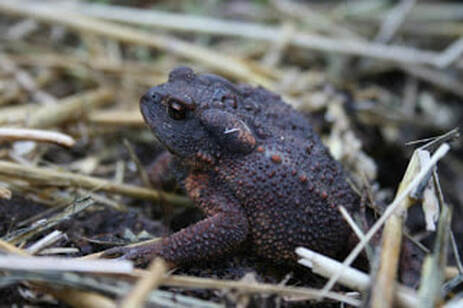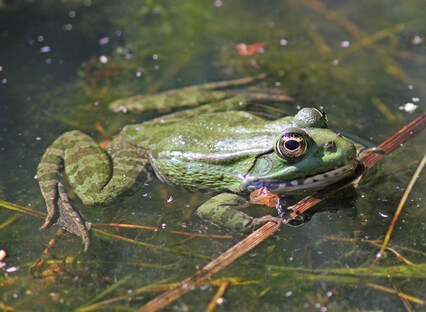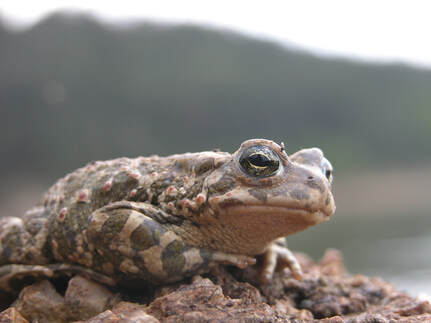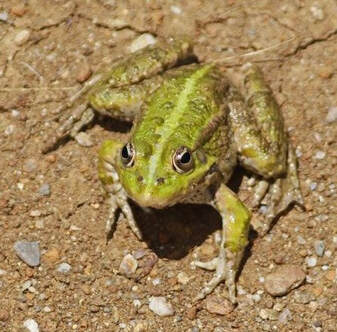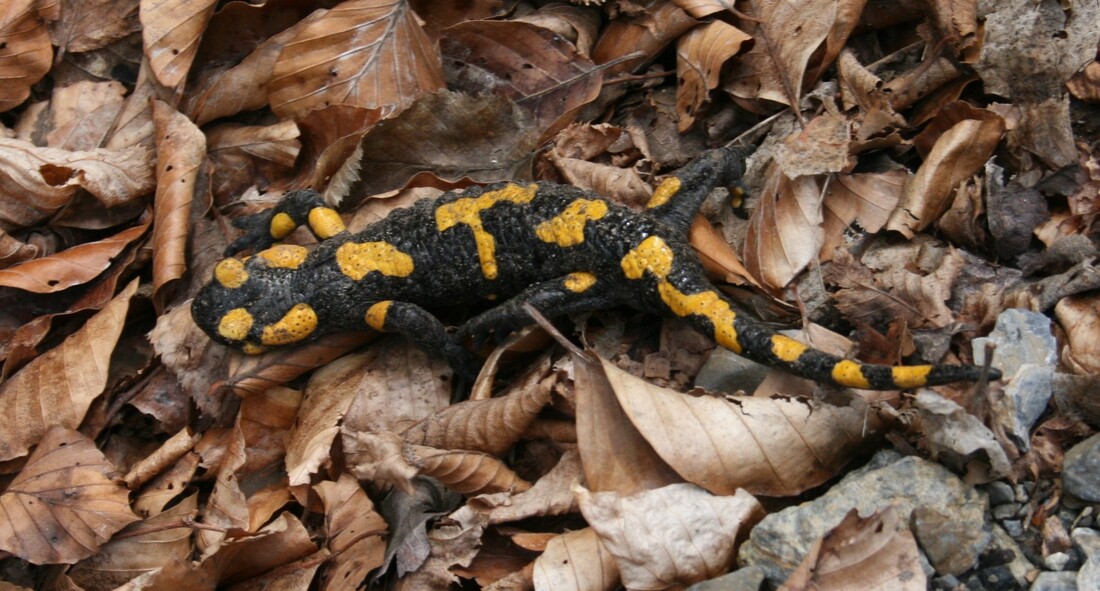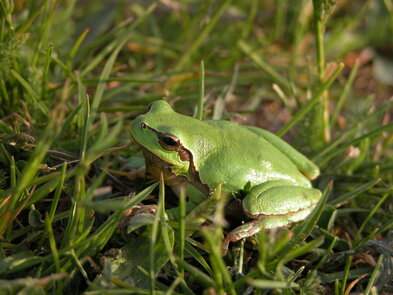Common Toad - Bufo bufo |
Common frog - Rana temporaria |
|
Size
The common toad can reach about 15 cm (6 in) in length. Females are normally stouter than males and southern specimens tend to be larger than northern ones. Habitat It spends the day concealed in a lair that it has hollowed out under foliage or beneath a root or a stone where its coloring makes it inconspicuous. It emerges at dusk and may travel some distance in the dark while hunting. It is most active in wet weather. By morning it has returned to its base and may occupy the same place for several months. Diet It is voracious and eats woodlice, slugs, beetles, caterpillars, flies, earthworms and even small mice. Breeding Common toads tend to live away from water, except when mating, and hibernate during the winter in deep leaf litter, log piles and in burrows. During mating, the male clutches the female from behind in a tight embrace. He fertilizes the long, triple-stranded strings of eggs as she lays them among the water weeds. |
Size
Males are distinguishable from females as they are smaller. The adult common frog has a body length of 6 to 9 centimetres (2.4 to 3.5 in). Habitat Outside the breeding season, common frogs live a solitary life in damp places near ponds or marshes or in long grass. They are normally active for much of the year, only hibernating in the coldest months. The common frog is found throughout much of Europe as far north as northern Scandinavia. Diet They feed on any invertebrate of a suitable size, catching their prey on their long, sticky tongues, although they do not feed at all during the short breeding season. Preferred foods include insects (especially flies), snails, slugs and worms. Breeding Common frogs breed in shallow, still, fresh water such as ponds, with spawning commencing sometime between March and late June, but generally in April over the main part of their range. The adults congregate in the ponds, where the males compete for females. |
Green Toad - Bufo viridisSize
They are not large toads; adult males are about 37–46 mm (1.5–1.8 in) in snout–vent length and females 44–54 mm (1.7–2.1 in). Habitat Can be found in steppes, mountainous areas, semi-deserts, urban areas and other habitats in mainland Europe, ranging from far eastern France and Denmark to the Balkans and Western Russia. Diet Green toads feed on a variety of small invertebrates, such as ants, small butterflies and moths, beetles, and small grasshoppers. Breeding Breeding occurs from late March to August, stimulated by summer rains. |
Marsh frog -Pelophylax ridibundusSize
The marsh frog is a water-dwelling, generally green-coloured frog species. It can reach a maximum length of 17 centimetres, but males remain smaller (around 12 cm). Habitat They can be found in deep ponds, lakes, rivers and around streams across the continent. The range of the marsh frog is wider than it once was, as the marsh frog is also found in parts of western Asia and Russia and even in some areas in China and Pakistan. Diet The diet of the marsh frog consists of dragonflies and other insects, spiders, earthworms, and slugs. Larger frogs also eat small rodents and sometimes smaller amphibians and fish. Breeding Marsh frogs tend to breed in the early spring, when mating takes place in calm, shallow pools of water. The female marsh frog lays around 1,000 eggs in a sticky cluster that floats on the water's surface |
|
Size
The fire salamander can grow to be 15–25 centimetres (5.9–9.8 in) long. Females are usually slightly bigger than males. Habitat Fire salamanders live in central Europe forests and are more common in hilly areas. They prefer deciduous forests since they like to hide in fallen leaves and around mossy tree trunks. They need small brooks or ponds with clean water in their habitat for the development of the larvae. Diet The diet of the fire salamander consists of various insects, spiders, earthworms and slugs, but they also occasionally eat newts and young frogs. Breeding Fire salamanders mate on land, with the male depositing a spermatophore during the course of a ritualised courtship display. The female will then pick up this sperm packet with her cloaca for subsequent internal fertilisation of her eggs. Mating may be observed throughout the year, only if the weather is right. |
Size
European tree frogs are small; males range from 32–43 mm (1.3–1.7 in) in length, and females range from 40–50 mm (1.6–2.0 in) in length. Habitat They are found across most of Europe (except Ireland). European tree frogs can be found in marshlands, damp meadows, reed beds, parks, gardens, vineyards, orchards, stream banks, lakeshores, or humid or dry forests. They tend to avoid dark or thick forests, and they are able to tolerate some periods of dryness; therefore, sometimes they are found in dry habitats. Diet European tree frogs eat a variety of small arthropods, such as spiders, flies, beetles, butterflies, and smooth caterpillars. Their ability to take long leaps allow them to catch fast-flying insects, which make up most of their diets. Breeding European tree frogs reproduce in stagnant bodies of water, such as lakes, ponds, swamps, reservoirs, and sometimes puddles, from late March to June. They croak in the breeding season, even when migrating to their mating pools or ponds. Males will often change breeding ponds, even within the same breeding season. |
This page was made by Dylan Alfrey, for more information on Reptiles and Amphibians of Bulgaria see Dylan's website Bulgarian Reptiles here and his Balkan Herping youtube channel here
Telephone+359988342649
|
|

